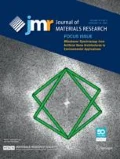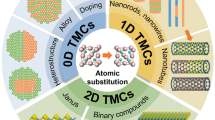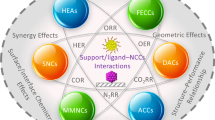Abstract
Using the thermal oxidation of iron, we show that the growth morphologies of one-dimensional nanostructures of hematite (α-Fe2O3) can be tuned by varying the oxygen gas pressure. It is found that the oxidation at the oxygen gas pressures of ∼0.1 Torr is dominated by the growth of hematite nanobelts, whereas oxidation at pressure near 200 Torr is dominated by the growth of hematite nanowires. Detailed transmission electron microscopy study shows that both the nanobelts and nanowires grow along the direction with a bicrystal structure. It is shown that nanowires are rooted on Fe2O3 grains, whereas nanobelts are originated from the boundaries of Fe2O3 grains. Our results show that oxygen gas pressure can be used to manipulate the Fe2O3/Fe3O4 interfacial reaction, thereby tailoring the oxide growth morphologies via the stress-driven diffusion.







Similar content being viewed by others
References
K.A. Dick: A review of nanowire growth promoted by alloys and non-alloying elements with emphasis on Au-assisted III-V nanowires. Prog. Cryst. Growth Charact. Mater. 54, 138 (2008).
J. Lu, P. Chang, and Z. Fan: Quasi-one-dimensional metal oxide materials-synthesis, properties and applications. Mater. Sci. Eng., R 52, 49 (2006).
E. Comini, C. Baratto, G. Faglia, M. Ferroni, A. Vomiero, and G. Sberveglieri: Quasi-one-dimensional metal oxide semiconductors: Preparation, characterization and application as chemical sensors. Prog. Mater Sci. 54, 1 (2009).
E. Park, S. Shim, R. Ha, E. Oh, B.W. Lee, and H.J. Choi: Reassembling of Ni and Pt catalyst in the vapor-liquid-solid growth of GaN nanowires. Mater. Lett. 65, 2458 (2011).
J. Paek, M. Yamaguchi, and H. Amano: MBE-VLS growth of catalyst-free III-V axial heterostructure nanowires on (111)Si substrates. J. Cryst. Growth 323, 315 (2011).
R. Schwertberger, D. Gold, J.P. Reithmaier, and A. Forchel: Epitaxial growth of 1.55 μm emitting InAs quantum dashes on InP-based heterostructures by GS-MBE for long-wave length laser applications. J. Cryst. Growth 251, 248 (2003).
C. Gatel, H. Tang, C. Crestou, A. Ponchet, N. Bertru, F. Dore, and H. Folliot: Analysis by high-resolution electron microscopy of elastic strain in thick InAs layers embedded in Ga0.47In0.53As buffers on InP(001) substrate. Acta Mater. 58, 3238 (2010).
Z.H. Zhang, K. Sumitomo, F. Lin, H. Omi, and T. Ogino: Structure transition of Ge/Si(113) surfaces during Ge epitaxial growth. Physica E 24, 157 (2004).
N. Motta, A. Sgarlata, R. Calarco, Q. Nguyen, J.C. Cal, F. Patella, A. Balzarotti, and M. De Crescenzi: Growth of Ge-Si(111) epitaxial layers: Intermixing, strain relaxation and island formation. Surf. Sci. 406, 254 (1998).
H.J. Fan, A.S. Barnard, and M. Zacharias: ZnO nanowires and nanobelts: Shape selection and thermodynamic modeling. Appl. Phys. Lett. 90, 143116 (2007).
A.S. Barnard: A thermodynamic model for the shape and stability of twinned nanostructures. J. Phys. Chem. B 110, 24498 (2006).
A.S. Barnard, Y. Xiao, and Z. Cai: Modelling the shape and orientation of ZnO nanobelts. Chem. Phys. Lett. 419, 313 (2006).
X.C. Jiang, T. Herricks, and Y.N. Xia: CuO nanowires can be synthesized by heating copper substrates in air. Nano Lett. 2, 1333 (2002).
M.L. Zhong, D.C. Zeng, Z.W. Liu, H.Y. Yu, X.C. Zhong, and W.Q. Qiu: Synthesis, growth mechanism and gas-sensing properties of large-scale CuO nanowires. Acta Mater. 58, 5926 (2010).
C.H. Xu, C.H. Woo, and S.Q. Shi: Formation of CuO nanowires on Cu foil. Chem. Phys. Lett. 399, 62 (2004).
F. Rizzo, S.R.J. Saunders, and M. Monteiro: The oxidation behaviour of metals and alloys at high temperatures in atmospheres containing water vapour: A review. Prog. Mater Sci. 53, 775 (2008).
Y.L. Chueh, M.W. Lai, J.Q. Liang, L.J. Chou, and Z.L. Wang: Systematic study of the growth of aligned arrays of α-Fe2O3 and Fe3O4 nanowires by a vapor-solid process. Adv. Funct. Mater. 16, 2243 (2006).
R. Nakamura, G. Matsubayashi, H. Tsuchiya, S. Fujimoto, and H. Nakajima: Formation of oxide nanotubes via oxidation of Fe, Cu and Ni nanowires and their structural stability: Difference in formation and shrinkage behavior of interior pores. Acta Mater. 57, 5046 (2009).
R. Takagi: Growth of oxide whiskers on metals at high temperature. J. Phys. Soc. Jpn. 12, 1212 (1957).
X.G. Wen, S.H. Wang, Y. Ding, Z.L. Wang, and S.H. Yang: Controlled growth of large-area, uniform, vertically aligned arrays of α-Fe2O3 nanobelts and nanowires. J. Phys. Chem. B 109, 215 (2005).
D.A. Voss, E.P. Butler, and T.E. Michell: The growth of hematite blades during the high temperature oxidation of iron. Metall. Trans. A 13A, 929 (1982).
Q. Han, Y.Y. Xu, Y.Y. Fu, H. Zhang, R.M. Wang, T.M. Wang, and Z.Y. Chen: Defects and growing mechanisms of α-Fe2O3 nanowires. Chem. Phys. Lett. 431, 100 (2006).
Z. Dong, P. Kashkarov, and H. Zhang: Monte Carlo study for the growth of α-Fe2O3 nanowires synthesized by thermal oxidation of iron. Nanoscale 2, 524 (2010).
C.T. Hsieh, J.M. Chen, H.H. Lin, and H.C. Shih: Synthesis of well-ordered CuO nanofibers by a self-catalytic growth mechansim. Appl. Phys. Lett. 82, 3316 (2003).
L.S. Huang, S.G. Yang, T. Li, B.X. Gu, Y.W. Du, Y.N. Lu, and S.Z. Shi: Preparation of large-scale cupric oxide nanowires by thermal evaporation method. J. Cryst. Growth 260, 130 (2004).
R.A. Rapp: The high temperature oxidation of metals forming cation-diffusing scales. Metall. Mater. Trans. B 15, 195 (1984).
G. Raynaud and R. Rapp: In situ observation of whiskers, pyramids and pits during the high-temperature oxidation of metals. Oxid. Met. 21, 89 (1984).
P. Kofstad: High Temperature Corrosion (Elsevier Applied Science Publishers, Barking, UK, 1988, pp. 350–445).
A.M. Goncalves, L.C. Campos, A.S. Ferlauto, and R.G. Lacerda: On the growth and electrical characterization of CuO nanowires by thermal oxidation. J. Appl. Phys. 106, 034303 (2009).
A. Kumar, A.K. Srivastava, P. Tiwari, and R.V. Nandedkar: The effect of growth parameters on the aspect ratio and number density of CuO nanorods. J. Phys. Condens. Matter 16, 8531 (2004).
J.T. Chen, F. Zhang, J. Wang, G.A. Zhang, B.B. Miao, X.Y. Fan, D. Yan, and P.X. Yan: CuO nanowires synthesized by thermal oxidation route. J. Alloys Compd. 454, 268 (2008).
J. Chen, L. Xu, W. Li, and X. Gou: α-Fe2O3 nanotubes in gas sensor and lithium-ion battery applications. Adv. Mater. 17, 582 (2005).
C. Wu, P. Yin, C. OuYang, and Y. Xie: Synthesis of hematite (α-Fe2O3) nanorods: Diameter-size and shape effects on their applications in magnetism, lithium ion battery, and gas sensors. J. Phys. Chem. B 110, 17806 (2006).
Y.Y. Xu, X.F. Rui, Y.Y. Fu, and H. Zhang: Magnetic properties of α-Fe2O3 nanowires. Chem. Phys. Lett. 410, 36 (2005).
L.-C. Hsu, Y.-Y. Li, C.-G. Lo, C.-W. Huang, and G. Chern: Thermal growth and magnetic characterization of α-Fe2O3 nanowires. J. Phys. D Appl. Phys. 41, 185003 (2008).
L. Suber, P. Imperatori, G. Ausanio, F. Fabbri, and H. Hofmeister: Synthesis, morphology, and magnetic characterization of iron oxide nanowires and nanotubes. J. Phys. Chem. B 109, 7103 (2005).
L.-C. Hsu, Y.-Y. Li, and C.-Y. Hsiao: Synthesis, electrical measurement, and field emission properties of α-Fe2O3 nanowires. Nanoscale Res. Lett. 3, 330 (2008).
Y. Peng, H.L. Zhang, S.L. Pan, and H.L. Li: Magnetic properties and magnetization reversal of α-Fe nanowires deposited in alumina film. J. Appl. Phys. 87, 7405 (2000).
H. Wang, X. Zhang, B. Liu, H. Zhao, Y. Li, Y. Huang, and Z. Du: Synthesis and characterization of single crystal α-Fe2O3 nanobelts. Chem. Lett. 34, 184 (2005).
L.S. Zhong, J.S. Hu, H.P. Liang, A.M. Cao, W.G. Song, and L.J. Wan: Self-assembled 3D flowerlike iron oxide nanostructures and their application in water treatment. Adv. Mater. 18, 2426 (2006).
J. Jin, S. Ohkoshi, and K. Hashimoto: Giant coercive field of nanometer‐sized iron oxide. Adv. Mater. 16, 48 (2004).
J.J. Wu, Y.L. Lee, H.H. Chiang, and D.K. Wong: Growth and magnetic properties of oriented α-Fe2O3 nanorods. J. Phys. Chem. B 110, 18108 (2006).
U. Cvelbar, Z.Q. Chen, M.K. Sunkara, and M. Mozetic: Spontaneous growth of superstructure α-Fe2O3 nanowire and nanobelt arrays in reactive oxygen plasma. Small 4, 1610 (2008).
Y.Y. Fu, J. Chen, and J. Zhang: Synthesis of Fe2O3 nanowires by oxidation of iron. Chem. Phys. Lett. 350, 491 (2001).
Y.Y. Fu, R.M. Wang, J. Xu, J. Chen, Y. Yan, A.V. Narlikar, and H. Zhang: Synthesis of large arrays of aligned α-Fe2O3 nanowires. Chem. Phys. Lett. 379, 373 (2003).
A.G. Nasibulin, S. Rackauskas, H. Jiang, Y. Tian, P.R. Mudimela, S.D. Shandakov, L.I. Nasibulina, J. Sainio, and E.I. Kauppinen: Simple and rapid synthesis of α-Fe2O3 nanowires under ambient conditions. Nano Res. 2, 373 (2009).
Z.Q. Chen, U. Cvelbar, M. Mozetic, J.Q. He, and M.K. Sunkara: Long-range ordering of oxygen-vacancy planes in α-Fe2O3 nanowires and nanobelts. Chem. Mater. 20, 3224 (2008).
R.M. Wang, Y.F. Chen, Y.Y. Fu, H. Zhang, and C. Kisielowski: Bicrystalline hematite nanowires. J. Phys. Chem. B 109, 12245 (2005).
N. Birks, G.H. Meier, and F.S. Pettit: Introduction to the High Temperature Oxidation of Metals, 2nd ed. (Cambridge University Press, Cambridge, United Kingdom, 2006, pp. 83–86).
D. Young: High Temperature Oxidation and Corrosion of Metals (Elsevier, Oxford, United Kingdom, 2008, pp. 85–91).
L. Yuan, Y.Q. Wang, R. Mema, and G.W. Zhou: Driving force and growth mechanism for spontaneous oxide nanowire formation during the thermal oxidation of metals. Acta Mater. 59, 2491 (2011).
R. Mema, L. Yuan, Q. Du, Y.Q. Wang, and G.W. Zhou: Effect of surface stresses on CuO nanowire growth in the thermal oxidation of copper. Chem. Phys. Lett. 512, 87 (2011).
Acknowledgment
The research was supported by the National Science Foundation under the Grant No. CMMI-0825737.
Author information
Authors and Affiliations
Corresponding author
Rights and permissions
About this article
Cite this article
Yuan, L., Jiang, Q., Wang, J. et al. The growth of hematite nanobelts and nanowires—tune the shape via oxygen gas pressure. Journal of Materials Research 27, 1014–1021 (2012). https://doi.org/10.1557/jmr.2012.19
Received:
Accepted:
Published:
Issue Date:
DOI: https://doi.org/10.1557/jmr.2012.19




